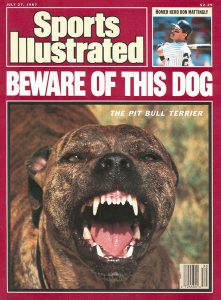“This post contains affiliate links, and I will be compensated if you make a purchase after clicking on my links.”
According to the American Pet Products Association, there are nearly 90 million pet dogs in the United States. For most owners, their dogs are part of their families. But insurance companies often disagree. To them, dogs are a liability. In fact, homeowners with certain breeds of dogs may have trouble getting homeowners insurance. Read on and find out how pet liability policies work, where breed bias comes from and what it means for homeowners.

Homeowners insurance and pet liability
Homeowners insurance typically covers damage to your property and the belongings within it, but it also protects you in case someone is injured on your property. In most cases, liability limits fall between $100,000 and $300,000 if your dog bites someone or damages another person’s property. Anything above the set threshold would be an out-of-pocket expense.
Like most insurance stipulations, pet liability coverage is left to state departments. States like California have dog-bite statutes, which means that in most cases, an owner is automatically liable for any property damage or injury their dog causes. Other states, like Texas, have a one-bite rule that only deems an owner responsible if their dog has already bitten someone or acted aggressively in the past. Then there are states that turn to negligence laws when one-bite rules don’t exist and a dog’s behavior can be tied to an owner’s carelessness.
Insurance companies can offer coverage based on their own risk tolerance, regardless of how your pet has behaved in the past. They might charge a high premium, exclude pet liability from your plan or deny coverage if you own a breed that is more likely to injure people or cause property damage.
Excluded dog breeds
Ask your provider if there’s a list of aggressive dogs or prohibited dog breeds that you can reference. Wondering whether your pup makes the cut? Excluded pets often include any dogs related to the following breeds:
- Akitas
- Alaskan Malamutes
- Chow Chows
- Doberman Pinschers
- German Shepherds
- Great Danes
- Bull Mastiffs
- Pit Bull Terriers
- Rottweilers
- Siberian Huskies
- Staffordshire Terriers
- Wolfhounds

Providers may look at historical claims or statistics, but they may also decide to deny insurance to owners with certain dogs based on media coverage. This became much more prevalent in the 1980s, when Sports Illustrated put a ferocious-looking pitbull on their cover with the headline “Beware of This Dog.” This fueled fear and changed public opinion about the breed.
The industry and owners at odds
More than 4.5 million people are bitten by dogs in the U.S. annually and more than 800,000 people seek medical attention, according to the Centers for Disease Control and Prevention (CDC). Worse, sources suggest that dog bite cases have risen over time. It’s certainly an important issue, but is punishing homeowners with certain dog breeds a viable solution to the problem?
The Insurance Information Institute reports that dog-related incidents cost more than $600 million in liability claim payouts in 2016. Providers have to do everything they can to limit their risk. Some studies have shown that pitbulls, Rottweilers and other targeted breeds are more likely to kill people or lead them to seek medical treatment.
Pet owners and advocates say that breed violence studies are fraught with potential error. There are inherent difficulties in breed identification, especially among mixed-breed dogs. And because there’s inconsistency in the data on dog bites, it’s difficult to calculate an actual bite rate for any given breed. In a piece published by the Connecticut Insurance Law Journal, Larry Cunningham points out that even the authors of the CDC study have stated that “breed discrimination is wrong and is not supported by scientific evidence.”
What’s next
Scientists and veterinarians cannot confidently state why certain dogs are more aggressive than others. An article published by the American Veterinary Medical Association says that the tendency to bite is dependent on at least five factors: heredity, early experience, socialization and training, medical and behavioral health and victim behavior. A dog’s lifestyle also affects its tendency toward aggression. The most dangerous dogs are those that were bred for dog fighting or protection. Dogs that endure neglect and abuse are also more likely to attack. Clearly, breed is not the only factor that determines whether a dog will harm others. In fact, any dog can bite or cause property damage.
Of course, heartwarming stories and personal anecdotes aren’t going to change things. Better data, legislation that challenges existing practices and widespread education about animal behavior are needed to end breed bias.

How to prevent dog bites
Dogs bite for a multitude of reasons. Aggressive behavior is usually a reaction to a stressful situation. Dogs bite when they feel scared, threatened or startled. Dogs will also bite to protect themselves or their owners. Ultimately, an owner is responsible for training their dog and ensuring that he or she acts appropriately.
To reduce the risk of dog-related incidents, you should expose your pup to other people and animals when they’re young. This will show them how to behave and ensure they’re comfortable in diverse situations. Play non-aggressive games with your pet like fetch as often as possible.
Another easy way to prevent your pup from attacking others is to have them spayed or neutered. Dogs are nearly three times more likely to bite if they aren’t fixed.
If your animal displays aggressive behavior, contact your vet and consider hiring an animal behaviorist or trainer to help. Obedience training and supervision can make a big difference.
Additional insurance options
Knowing how to prevent a dog bite is important, but you’ll need to take other measures if you’re having trouble getting insured because of breed bias. Ask your provider if they’ll cover your dog if you behavior train or muzzle them. Websites like BADRAP and MyPitBullisFamily can help you find national or local insurance companies that don’t discriminate against owners with certain kinds of pets, like Hippo.
If you don’t want to switch providers but have limited insurance coverage, consider an umbrella policy. It would provide a specific dollar amount of liability coverage for incidents your standard homeowners policy does not cover. A $1 million umbrella policy can cost as much as $300 annually.
You can also get a separate policy that provides a higher coverage limit for damages. Some companies offer dog liability insurance specifically for homeowners with breeds that are usually blacklisted.
Before you make any decisions, consult with an insurance professional and discuss coverage options and pet-specific policies in your state.
About the Author:
Hippo Insurance is a California-based insurtech company that is transforming home insurance for the modern household. Among its many innovations, Hippo allows homeowners to get a quote and purchase home insurance online in 60 seconds or less, save up to 25 percent compared with traditional insurers, and obtain smarter coverage for modern households. This includes protection for possessions like appliances, consumer electronics, and home offices.























